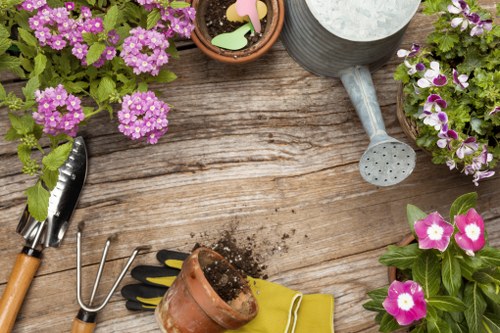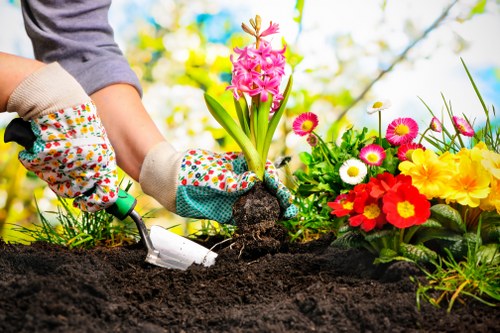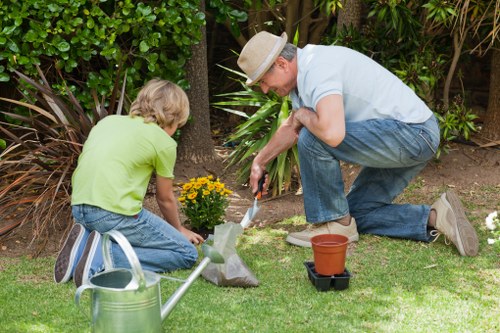The Essential Guide to Lawn Mowing within Gardening Services

Lawn mowing is a fundamental aspect of gardening services, playing a crucial role in maintaining the health and aesthetics of your outdoor spaces. Whether you have a sprawling backyard or a compact urban garden, regular lawn care ensures your grass remains lush, healthy, and visually appealing.
Proper lawn mowing not only enhances the curb appeal of your property but also contributes to the overall well-being of your garden. It helps in eliminating weeds, promoting healthy grass growth, and preventing pest infestations. In this article, we will delve into the various aspects of lawn mowing and how it integrates into comprehensive gardening services.
Understanding the importance of lawn mowing is the first step toward effective garden maintenance. It involves more than just cutting the grass; it's about maintaining the right height, frequency, and technique to ensure the longevity and health of your lawn.
Benefits of Regular Lawn Mowing

Regular lawn mowing offers numerous benefits that extend beyond mere aesthetics. Here are some key advantages:
- Enhanced Curb Appeal: A well-mowed lawn instantly boosts the appearance of your property, making it look well-maintained and inviting.
- Healthier Grass: Cutting the grass at the right height promotes stronger root systems and thicker grass, making your lawn more resilient.
- Weed Control: Regular mowing helps prevent weeds from taking over by removing the top growth of unwanted plants.
- Pest Prevention: Short grass reduces hiding spots for pests, minimizing the chances of infestation.
- Improved Safety: A tidy lawn reduces trip hazards and keeps the area safer for children and pets.
By incorporating lawn mowing into your gardening regimen, you ensure a harmonious and thriving outdoor environment.
Choosing the Right Mowing Technique

Adopting the correct mowing technique is essential for maintaining a healthy lawn. Here are some best practices:
- Maintain Proper Mower Height: Adjust your mower to cut the grass to the optimal height, typically between 2.5 to 3.5 inches, depending on the grass type. Cutting too short can stress the grass, while cutting too high may encourage weed growth.
- Mow Regularly: Establish a consistent mowing schedule, usually once a week during the growing season, to keep the grass at an even height.
- Alternate Mowing Patterns: Change the direction of mowing each time to prevent soil compaction and promote upright growth.
- Use Sharp Blades: Ensure mower blades are sharp to make clean cuts, reducing the risk of disease and promoting faster healing of grass blades.
- Avoid Mowing Wet Grass: Mowing when the grass is wet can lead to uneven cuts and clumping, which may harbor pests and diseases.
Implementing these techniques will significantly improve the health and appearance of your lawn.
Selecting the Right Equipment for Lawn Mowing

Choosing the appropriate mowing equipment is vital for efficient and effective lawn care. Various types of mowers cater to different lawn sizes and grass types:
- Push Mowers: Ideal for small to medium-sized lawns, push mowers are eco-friendly and require manual effort.
- Self-Propelled Mowers: Suitable for larger lawns, these mowers reduce the effort needed to push, making them easier to use.
- Riding Mowers: Best for extensive properties, riding mowers offer convenience and speed for large-scale mowing tasks.
- Mulching Mowers: These mowers finely chop grass clippings and distribute them back onto the lawn, providing natural fertilization.
- Robotic Mowers: Automated mowers that maintain your lawn with minimal intervention, ideal for tech-savvy gardeners.
Investing in high-quality mowing equipment ensures efficient maintenance and prolongs the lifespan of your mower.
Seasonal Lawn Mowing Tips

Different seasons require varying lawn mowing approaches to accommodate changes in grass growth patterns and weather conditions:
Spring
As grass begins to grow rapidly, it's essential to start mowing regularly. Gradually lower the mower height to encourage strong root development.
Summer
During the peak growing season, maintain a higher mowing height to retain moisture and provide shade to the roots, preventing drought stress.
Autumn
Continue regular mowing but gradually raise the mower height to prepare the lawn for winter, enhancing its resilience against cold temperatures.
Winter
Reduce mowing frequency as grass growth slows. Remove fallen leaves and debris to prevent mold and fungal growth.
Common Lawn Mowing Mistakes to Avoid

Avoiding common mistakes can significantly improve lawn health:
- Cutting Too Short: Mowing the grass too short can weaken it, making it susceptible to weeds and diseases.
- Infrequent Mowing: Letting the grass grow too long can lead to uneven cuts and stress the lawn.
- Using Dull Blades: Dull mower blades tear the grass, causing frayed edges that are prone to infection.
- Mowing in the Same Pattern: Repetitive mowing patterns can cause soil compaction and disrupt grass growth.
- Ignoring Lawn Health Signs: Failing to address issues like discoloration or pest damage can lead to larger problems.
By recognizing and correcting these errors, you can maintain a vibrant and healthy lawn.
Incorporating Lawn Mowing into Comprehensive Gardening Services

Lawn mowing is a key component of broader gardening services, complementing other maintenance tasks:
Integrating with Fertilization
Regular mowing facilitates the even distribution of fertilizer, promoting balanced grass growth and nutrient absorption.
Synchronizing with Irrigation
Properly timed mowing ensures that watering efforts are effective, preventing water wastage and ensuring deep soil penetration.
Combining with Weed Control
Mowing helps in managing weeds by removing their growth, making other weed control methods more effective.
Partnering with Pest Management
A well-maintained lawn reduces pest habitats, enhancing the effectiveness of pest control measures.
By integrating lawn mowing with other gardening services, you create a cohesive maintenance strategy that ensures the overall health and beauty of your outdoor spaces.
Eco-Friendly Lawn Mowing Practices

Adopting sustainable mowing practices benefits both your lawn and the environment:
- Mulching: Use mulching mowers to recycle grass clippings, returning nutrients to the soil and reducing the need for chemical fertilizers.
- Electric Mowers: Opt for electric or battery-operated mowers to minimize carbon emissions and noise pollution.
- Optimize Mowing Frequency: Mow only when necessary to reduce energy consumption and fuel usage.
- Maintain Equipment: Regularly servicing your mower ensures it operates efficiently, conserving energy and reducing emissions.
- Water Conservation: Mow at times that conserve water, such as early morning or late evening, to prevent evaporation.
Implementing these eco-friendly practices contributes to a healthier environment while maintaining a beautiful lawn.
Hiring Professional Lawn Mowing Services

While DIY mowing is an option, hiring professional lawn mowing services offers several advantages:
- Expertise: Professionals possess the knowledge and skills to maintain your lawn effectively, ensuring optimal health and appearance.
- Time-Saving: Outsourcing mowing tasks frees up your time for other activities, enhancing your overall productivity.
- Quality Equipment: Professional services use high-quality, well-maintained equipment, ensuring precise and efficient mowing.
- Consistent Maintenance: Regular service schedules ensure your lawn receives consistent care, preventing neglect and overgrowth.
- Customized Care: Professionals tailor their services to meet the specific needs of your lawn, addressing unique challenges and preferences.
Investing in professional lawn mowing services guarantees a well-maintained and vibrant lawn with minimal effort on your part.
Cost Considerations for Lawn Mowing Services

Understanding the cost factors associated with lawn mowing services helps you make informed decisions:
- Lawn Size: The larger the lawn, the higher the cost due to increased time and resources required.
- Frequency of Service: More frequent mowing schedules will naturally incur higher costs.
- Equipment Quality: High-end, professional-grade equipment may influence the pricing structure.
- Additional Services: Services such as trimming, edging, and fertilization can add to the overall cost.
- Location: Service rates may vary based on geographical location and local market rates.
When budgeting for lawn mowing services, consider these factors to ensure you receive value for your investment.
Maintaining Your Lawn Post-Mowing

Proper maintenance after mowing ensures the longevity and continued health of your lawn:
Remove Clippings
Regularly clearing grass clippings prevents them from suffocating the grass and encourages better air circulation.
Water Appropriately
Water your lawn after mowing to help the grass recover and maintain its green color.
Inspect for Pests and Diseases
Post-mowing is an excellent time to check for signs of pests or diseases, allowing for timely intervention.
Apply Fertilizer
Scheduled fertilization after mowing provides essential nutrients that support healthy grass growth.
Aerate the Soil
Aerating your lawn improves soil health by enhancing root penetration and nutrient absorption.
These maintenance steps complement regular mowing, fostering a robust and vibrant lawn.
Innovations in Lawn Mowing Technology

Advancements in technology have revolutionized lawn mowing, making it more efficient and user-friendly:
- Smart Mowers: Equipped with GPS and sensors, smart mowers navigate your lawn autonomously, ensuring precise mowing patterns.
- Battery-Powered Mowers: Offering quieter and eco-friendly operation, battery-powered mowers are becoming increasingly popular.
- Robotic Mowers: These automated devices maintain your lawn with minimal supervision, ideal for busy homeowners.
- App Integration: Modern mowers can be controlled and monitored via smartphone apps, providing convenience and customization.
- Solar-Powered Mowers: Harnessing solar energy, these mowers offer a sustainable and renewable power source.
Embracing these technological innovations can enhance the efficiency and effectiveness of your lawn mowing routine.
Environmental Impact of Lawn Mowing

Lawn mowing practices can have significant environmental implications. Here are some considerations:
Carbon Footprint
Gas-powered mowers emit carbon dioxide, contributing to greenhouse gas emissions. Opting for electric or manual mowers can reduce your carbon footprint.
Biodiversity
A well-maintained lawn supports a variety of plant and animal species. Avoiding excessive pesticide use and promoting native grasses can enhance biodiversity.
Water Usage
Efficient mowing practices, combined with proper irrigation, can optimize water usage and prevent wastage.
Soil Health
Regular mowing and aeration improve soil structure, promoting better nutrient retention and moisture absorption.
Noise Pollution
Electric and battery-powered mowers operate more quietly, minimizing noise pollution and disturbance to the surrounding environment.
Implementing eco-friendly mowing practices leads to a sustainable and environmentally responsible lawn maintenance routine.
Tips for a Beautiful Lawn All Year Round

Maintaining a beautiful lawn throughout the year requires consistent care and attention. Here are some essential tips:
- Regular Mowing: Stick to a consistent mowing schedule to keep your grass healthy and attractive.
- Proper Watering: Water deeply and infrequently to encourage deep root growth.
- Fertilization: Apply appropriate fertilizers based on your grass type and seasonal needs.
- Weed Control: Stay vigilant against weeds and address them promptly.
- Soil Testing: Periodically test your soil to ensure optimal pH levels and nutrient content.
- Seasonal Cleanup: Remove debris, fallen leaves, and dead grass to prepare your lawn for the upcoming season.
- Aeration: Aerate your lawn annually to improve soil health and grass growth.
- Overseeding: Introduce new grass seeds to fill in bare spots and enhance lawn density.
By following these tips, you can enjoy a vibrant and healthy lawn through every season.
Conclusion

Lawn mowing is an integral part of gardening services, essential for maintaining a healthy and aesthetically pleasing lawn. By understanding the benefits, adopting the right techniques, and utilizing proper equipment, you can ensure your lawn remains vibrant and resilient.
Whether you choose to mow your lawn yourself or hire professional services, prioritizing regular maintenance and eco-friendly practices will contribute to a thriving outdoor space. Embrace the art of lawn mowing as part of your comprehensive gardening strategy and enjoy the beauty and benefits of a well-kept lawn year-round.
Ready to transform your lawn? Contact us today to schedule your professional lawn mowing service and take the first step toward a healthier, more beautiful garden.